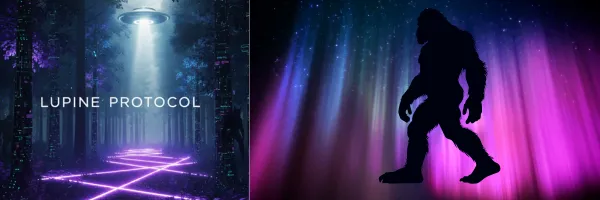

Before Bigfoot: A History of America's "Wild Men"
Before Bigfoot: A History of America's "Wild Men"
Table of Contents
Introduction: A Phenomenon Before a Name
The story of "Bigfoot" as a cultural icon began on August 27, 1958. On that day, bulldozer operator Jerry Crew found enormous, 16-inch human-like tracks around his construction site in Bluff Creek, California. His discovery, and the subsequent "Bigfoot" moniker coined by a local newspaper, launched a modern legend. But the 1958 incident wasn't a beginning; it was merely a rebranding.
The historical record is filled with accounts of large, hairy, bipedal creatures that predate the name by centuries. These stories, told by Indigenous peoples, early European settlers, prospectors, and even a future president, paint a picture of a continent long inhabited by mysterious "Wild Men." This dossier is an investigation into that deep, complex history.
The "Wild Man" Archetype in the Settler's Mind
When European settlers arrived in North America, they brought with them a pre-existing cultural concept of the "Wild Man of the Woods" (or Woodwose). This figure from European folklore—a hairy, powerful, often club-wielding humanoid living on the fringes of civilization—provided a ready-made framework for interpreting the vast, intimidating wilderness of the New World. Any glimpse of a large, unknown primate, or even a reclusive native, could be filtered through this familiar lens. Early newspaper accounts are thus a fascinating mix of genuine wonder, fear, and cultural projection.
What Were the Key 19th-Century "Wild Man" Reports?
As settlers pushed west, encounters with strange, ape-like beings began to appear frequently in local newspapers and journals. While some were undoubtedly hoaxes or misidentifications, their consistency and geographical spread are notable, suggesting a widespread phenomenon.
The Arkansas "Wild Man" (1851): An early and influential account appeared in the Memphis Enquirer, detailing a creature sighted in Greene County, Arkansas. It was described as being covered in hair, leaving 13-inch tracks, and having "superhuman strength." The report stated it was "screaming like a panther" and terrorizing the local populace, a theme that would recur in many future sightings.
The Jacko Incident (1884): One of the most famous early accounts comes from the July 4, 1884, edition of the British Columbia newspaper, the Daily Colonist. It reported the capture of a small, ape-like creature near the town of Yale. Nicknamed "Jacko," the creature was described as "something of the gorilla type" and covered in thick, black hair. Despite the detailed report, Jacko mysteriously vanished from the historical record, leading many to speculate it either died or was quietly sold to a showman like P.T. Barnum.
Theodore Roosevelt's Tale (1893): In his book, "The Wilderness Hunter," future president Theodore Roosevelt recounted a story told to him by a grizzled mountain man named Bauman. The story detailed a harrowing encounter in the Rocky Mountains where Bauman's trapping partner was killed and his camp terrorized by a large, bipedal creature that left human-like tracks. Roosevelt, a noted naturalist, presented the story as a firsthand account of frontier terror, concluding, "I think that in the hideous conditions of Bauman's tragedy may be found explanation of the facts on which the stories of the 'Wild Men' of the mountains are based."
Did "Wild Man" Sightings Continue into the 20th Century?
Yes, the turn of the century did not slow the reports. As logging and mining pushed deeper into remote territories, encounters became more frequent and, in some cases, more aggressive. This era produced some of the most foundational cases in modern Sasquatch research.
Albert Ostman's Abduction Account (1924): In a story he did not make public until 1957, prospector Albert Ostman claimed he was abducted and held captive for six days by a family of four Sasquatch near Toba Inlet, British Columbia. He described a family unit consisting of a large male, a female, a young male, and a young female, providing detailed observations of their behavior, diet, and apparent language.
The Ape Canyon Siege (1924): This is perhaps the most significant proto-Bigfoot event. A group of five miners working a claim near Mount St. Helens, Washington, reported a terrifying, multi-hour assault on their cabin. They claimed multiple "ape-men" or "mountain gorillas" bombarded the cabin with large rocks and tried to break in. The miners fled the mountain the next day, and their story, filled with genuine terror, has become a cornerstone of Sasquatch research. The consistency of their accounts and their refusal to profit from the tale lends it significant credibility.
The Ruby Creek Incident (1941): In a stark contrast to the violence of Ape Canyon, the Chapman family of Ruby Creek, British Columbia, reported a series of encounters with a curious but peaceful creature. They claimed a very large, hairy hominid repeatedly visited their property over several weeks, observing the family from a distance before eventually disappearing.
Conclusion: A Deeply Rooted American Mystery
The evidence is clear: the phenomenon of a large, unrecognized hominid in North America existed long before the name "Bigfoot" was ever printed. The term coined in 1958 was not the birth of a mystery, but simply a new name for a very old one. From the Indigenous legends that form the bedrock of this phenomenon, to the scattered but consistent accounts of early settlers and prospectors, the story is far older than a single set of tracks in Northern California.
These historical accounts provide a rich and vital context, suggesting that what we call Bigfoot today is not a modern invention, but the latest chapter in a long and perplexing history of encounters with the "Wild Men" of the American wilderness.
Explore The Mysteries
welcome to the central archive. Lupine Protocol is a unified platform dedicated to the methodical investigation of unexplained phenomena. We bring a data-driven, evidence-based approach to the subjects that exist on the fringes of conventional science. Whether you're a seasoned researcher or a curious newcomer, our mission is to provide the resources, tools, and in-depth analysis you need to explore the world's most enduring mysteries.

Cryptozoology

UFO/UAP

The Unexplained

"Whether you're documenting the undocumented, investigating the inexplicable, or just addicted to the unknown—this is where legends are born."

Pages
Listed On


Information

© 2025 ward media projects - All Rights Reserved.



